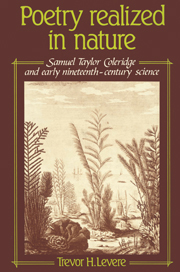Book contents
- Frontmatter
- Contents
- Preface
- Introduction: nature and mind
- CHAPTER 1 Early Years: From Hartley to Davy
- CHAPTER 2 Surgeons, Chemists, and Animal Chemists: Coleridge's Productive Middle Years From the Biographia Literaria to Aids to Reflection
- CHAPTER 3 Two Visions of the World: Coleridge, Natural Philosophy, and the Philosophy of Nature
- CHAPTER 4 Coleridge and Metascience: Approaches to Nature and Schemes of the Sciences
- CHAPTER 5 The Construction of the World: Genesis, Cosmology, and General Physics
- CHAPTER 6 Geology and Chemistry: The Inward Powers of Matter
- CHAPTER 7 Life: Crown and Culmination
- Notes
- Index
CHAPTER 5 - The Construction of the World: Genesis, Cosmology, and General Physics
Published online by Cambridge University Press: 09 October 2009
- Frontmatter
- Contents
- Preface
- Introduction: nature and mind
- CHAPTER 1 Early Years: From Hartley to Davy
- CHAPTER 2 Surgeons, Chemists, and Animal Chemists: Coleridge's Productive Middle Years From the Biographia Literaria to Aids to Reflection
- CHAPTER 3 Two Visions of the World: Coleridge, Natural Philosophy, and the Philosophy of Nature
- CHAPTER 4 Coleridge and Metascience: Approaches to Nature and Schemes of the Sciences
- CHAPTER 5 The Construction of the World: Genesis, Cosmology, and General Physics
- CHAPTER 6 Geology and Chemistry: The Inward Powers of Matter
- CHAPTER 7 Life: Crown and Culmination
- Notes
- Index
Summary
The construction of matter
Length, breadth, and depth are the three dimensions of matter corresponding to the linear axis of magnetism, the superficial charge given to bodies by static electricity, and the inner chemical effects of a galvanic cell. They can be seen as the keys to the creation of three-dimensional matter and of the cosmos, whereas the activity of the powers of attraction and repulsion, symbolized in the magnet and corresponding to the power of length, represents the first stage of that construction. Because the creation of matter and of the cosmos was initiated and effected by an act of divine will, matter could provide an image of that act of will, reminding one of the spiritual origin of nature. Thus Coleridge once described matter as “the phantom of the Absolute Will.” To him, matter was at once a reality and an abstraction, to be distinguished from body: “When we think Body in the abstract, we call the result Matter: when we imagine Matter in the concrete, we call it Body.” His concept was here analogous to Aristotle's, wherein matter and form underlay the actuality of bodies. But for Coleridge, unlike Aristotle, matter could exist independently of body – for example, in the phenomenon of light, which he regarded as material although not corporeal.
Matter, then, was generated by an interaction of polar powers, existed in virtue of those powers, and was essentially active.
- Type
- Chapter
- Information
- Poetry Realized in NatureSamuel Taylor Coleridge and Early Nineteenth-Century Science, pp. 122 - 158Publisher: Cambridge University PressPrint publication year: 1981



